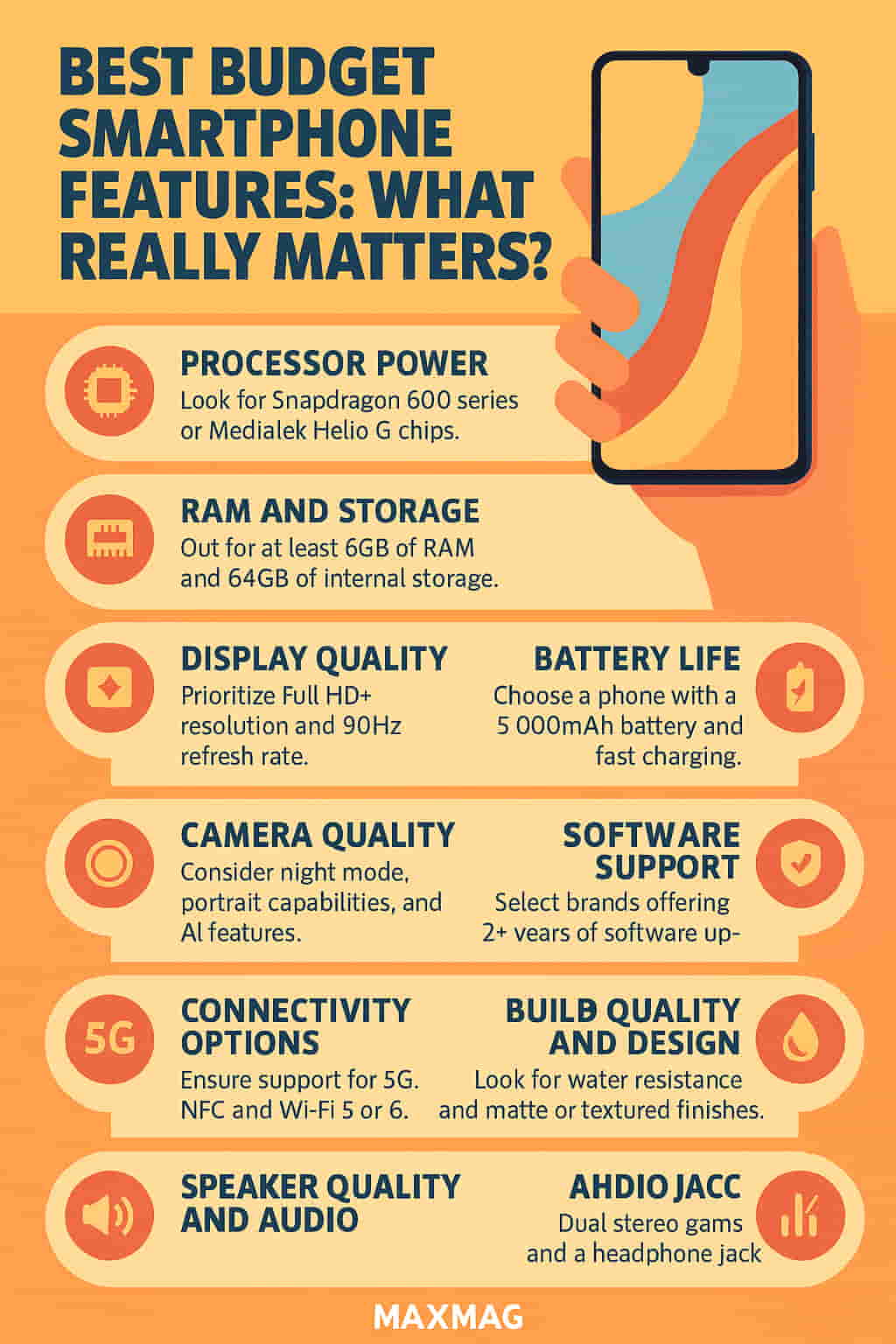
In a world saturated with tech options, choosing a phone can feel overwhelming. But if you’re not planning to spend a fortune, understanding the best budget smartphone features becomes essential. From processor power to display quality, even affordable models now offer impressive specs. Knowing what truly matters can save you hundreds of dollars while delivering solid performance for daily use.
1. Processor Power: The Heart of Your Smartphone
When exploring the best budget smartphone features, the processor—or System on a Chip (SoC)—is crucial. It controls how your phone handles apps, games, and multitasking. For budget options, look for models with Qualcomm Snapdragon 600 or MediaTek Helio G-series chips.
Processors like the Snapdragon 695 offer excellent performance for the price. According to AnandTech, mid-tier chips are now rivaling premium ones from just a few years ago.
2. RAM and Storage: Balancing Multitasking and Media
Most budget devices offer 4GB to 6GB of RAM. For smooth multitasking, 6GB is ideal. Internal storage of 64GB is the minimum you should accept—especially if the phone lacks microSD expansion. Cloud storage helps, but local storage still matters for apps and media.
Android Authority explains how 6GB RAM is the new standard for performance on affordable Androids.
3. Display Quality: Not Just About Size
The screen is your window to everything, so don’t overlook resolution and refresh rate. Among the best budget smartphone features, a Full HD+ display (1080p) with at least 90Hz refresh rate stands out. Avoid phones stuck at 720p or 60Hz—they’re harder on the eyes and feel laggy.
For sunlight visibility and contrast, OLED displays are ideal—but rare in this price range. Some mid-range models like the Samsung A-series offer OLED even at lower prices, as noted by Tom’s Guide.
4. Battery Life: All-Day Power
No matter how flashy the screen or fast the processor, poor battery life kills the experience. Look for phones with at least 5,000mAh batteries. That, combined with energy-efficient chips, ensures full-day use.
Fast charging also matters. Many top picks now offer 18W or even 33W charging. CNET reports that budget phones with large batteries often outperform flagships in endurance tests.
5. Camera Quality: More Than Megapixels
Affordable phones often tout high megapixel counts, but don’t be fooled. Image quality depends on sensor size, software optimization, and lens quality.
Among the best budget smartphone features, look for night mode, portrait mode, and AI enhancement. The Google Pixel 6a is a standout in this category thanks to its software processing, even with an older sensor, as reviewed by The Verge.
6. Software Support and Updates
You’ll want a phone that stays up to date, both for security and functionality. Many Android brands offer two years of software support, but Google and Samsung lead with longer commitments.
Phones in the Android One program or those from major brands tend to receive more consistent updates. For iOS users, even older iPhones continue receiving updates for 4–5 years, according to Apple’s support timeline.
7. Connectivity Options Matter
Even in budget phones, look for 5G support, Wi-Fi 5/6, and NFC (if you plan to use contactless payments). USB-C charging is now common, but some older models still use micro-USB—avoid these.
For travelers or dual-SIM users, eSIM support can be a plus.
8. Build Quality and Design
Budget doesn’t have to mean flimsy. Plastic can be durable and lightweight, and some phones offer water resistance ratings like IP52 or IP68. For a better grip and fewer fingerprints, matte finishes or textured backs are excellent choices.
As PCMag notes, manufacturers are putting more design effort into affordable devices—so don’t settle for bulky, unattractive phones.
9. Speaker Quality and Audio
Audio is often overlooked, but it makes a difference. Dual stereo speakers are becoming more common in this segment. If you still use wired headphones, ensure your phone includes a 3.5mm headphone jack—many still do in this range.
Hi-Res Audio certification and DTS enhancements can elevate your music and gaming experience without needing premium devices.
H2: best budget smartphone features to prioritize
With so many specs flying around, here are five best budget smartphone features to focus on:
-
Reliable processor: Snapdragon 600 series or equivalent
-
1080p+ Display with 90Hz+
-
5,000mAh battery + fast charging
-
Software support for 2+ years
-
Dual cameras with decent night mode
By narrowing your criteria to these essentials, you’ll get the best value.
10. Bonus Tips Before Buying
-
Compare prices using tools like Google Shopping.
-
Watch YouTube reviews for real-world impressions.
-
Look for deals during Black Friday or back-to-school seasons.
FAQ – Buying a Budget Smartphone
Q: Are budget smartphones worth it in 2025?
Yes. Thanks to hardware innovation and competition, many budget phones offer premium-level features at half the price.
Q: Can I use a budget phone for gaming?
Yes, depending on the chip. Phones with Snapdragon 695 or MediaTek G95 can handle most games smoothly.
Q: Is 5G necessary in a budget phone?
It’s not essential for everyone but is future-proofing if you plan to keep the phone for years.
Q: What’s the best screen type in budget models?
IPS LCDs are most common, but AMOLED/OLED is ideal when available for richer colors and deeper blacks.
Q: How long will a budget smartphone last?
With good care and software support, a quality budget phone can last 2–3 years easily.
Conclusion
Navigating the smartphone market doesn’t have to feel like decoding a tech manual. By focusing on the best budget smartphone features, you can find a phone that delivers excellent value without sacrificing core performance. From long battery life and sharp displays to secure software and solid cameras, today’s affordable phones are smarter than ever—and so are the buyers who choose them.





